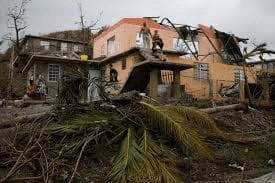Hurricane Maria Aftermath: FEMA Says Agency Was Unprepared To Face Storm Severity – By Arathi M (ibtimes.com) / July 13 2018
When Hurricane Maria made landfall in Puerto Rico on Sept. 20, 2017, the island was just recovering from the aftermath of storm Irma, which left thousands of people homeless and a million without power.
With three major storms hitting the United States in quick succession — Irma, Harvey and Maria — the authorities were clearly ill-equipped for the devastations these hurricanes would wreak. This unpreparedness was detailed in a report released Thursday by the Federal Emergency Management Agency (FEMA), which had plans that were more suitable for dealing with disasters such as a tsunami or an earthquake.
According to the report, when hurricane Maria hit Puerto Rico, FEMA’s efforts and material aids were concentrated on the Virgin Islands which were suffering from another storm that had hammered them more than a week ago.
“While FEMA mobilized billions of dollars in commodities, the agency experienced challenges in comprehensively tracking resources moving across multiple modes of transportation to Puerto Rico and the U.S. Virgin Islands due to staffing shortages and business process shortfalls,” the report said.
People rest outside a damaged house after the area was hit by Hurricane Maria in Yabucoa, Puerto Rico, Sept. 22, 2017. Photo: REUTERS/Carlos Garcia Rawlins
FEMA maintained it had a stockpile of commodities in Puerto Rico for a quick response to incidents. However, after Hurricane Irma hit the Virgin Islands, all commodities were sent there, after which storm Maria hit Puerto Rico.
“Distribution activities following Hurricane Irma created an immediate deficit of commodities at the warehouse, requiring additional items to be transported in the days immediately prior to and following Hurricane Maria’s landfall,” the report elaborated. “In response to Hurricane Irma impacts, FEMA distributed more than 80 percent of its inventory for selected commodities from the Caribbean Distribution Center warehouse. Hurricane Maria struck before supplies were replenished.”
In the report, the leadership of the agency acknowledged they could have anticipated the destruction the hurricanes would cause and acted accordingly.
“Leadership also recognized that emergency managers at all levels could have better leveraged existing information to proactively plan for and address such challenges, both before and immediately after the hurricanes,” it said.
The document released by the agency also backed the criticism leveled against FEMA after the storm — one of the worst to hit the island in its modern history — hammered Puerto Rico. Apart from the agency, President Donald Trump’s administration also faced significant criticism, especially after the POTUS visited the island and talked about how they “threw our budget a little out of whack.”
Trump’s comment came at a time when the island was facing severe diesel shortage, which led to the shutdown of supermarkets and generators, and hospitals were struggling to continue functioning.
A recent report by Harvard University claimed Hurricane Maria and its aftermath led to the deaths of at least 4,600 people, which is a significant increase from the initial official count of 64.
The report went on to say how the 2017 hurricane season in the United States led to five million people registering for assistance with the agency, which badly stretched its capacity as the storms together had caused about $265 billion in damages.
Puerto Rico continues to struggle to deal with the aftermath of Hurricane Maria and even though 10 months have passed since the storm made landfall, 1,000 households are still without power and many are still homeless, New York Times reported.



















